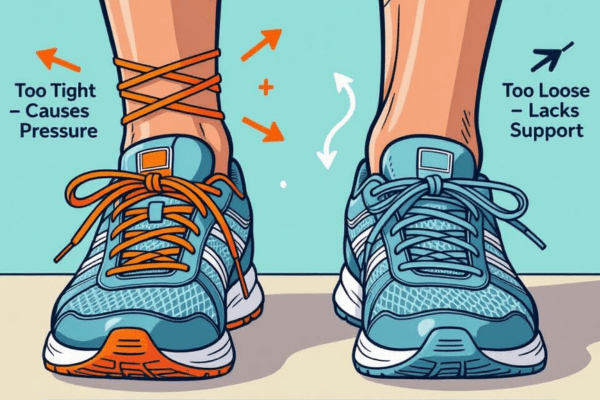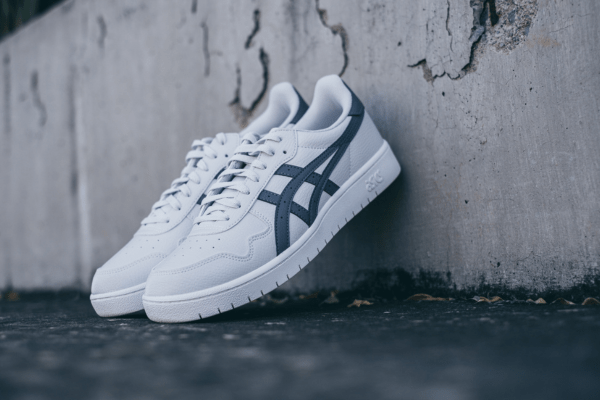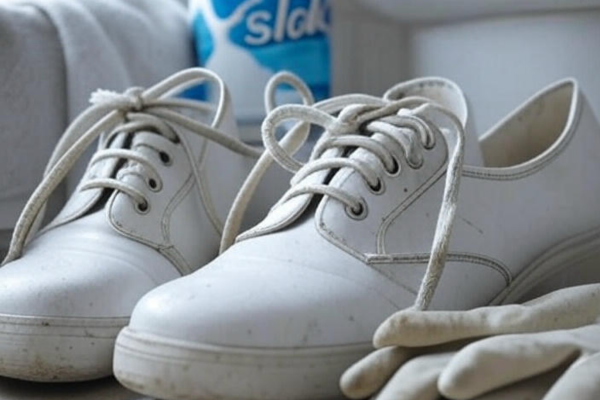1. Introduction
Plantar fasciitis is a widespread foot problem characterized by intense pain in the heel, caused by irritation and swelling of the plantar fascia—a sturdy tissue band linking the heel to the front of the foot. One effective way to manage this discomfort is through lacing shoes for plantar fasciitis relief. Effective shoe lacing boosts foot support, creates a comfortable fit, and promotes even pressure distribution across the foot. This reduces strain on the plantar fascia and can significantly decrease heel pain, making everyday activities more comfortable.
2. Why Lacing Matters in Plantar Fasciitis
Proper lacing plays a crucial role in managing plantar fasciitis because it directly affects how your shoe fits and how pressure is distributed across your foot. When shoes are laced too tight or too loose, uneven pressure concentrates around the heel, leading to increased heel pain and discomfort. Adjusting shoe tightness for heel pain helps ensure optimal shoe fit, providing the necessary support to reduce strain on the plantar fascia ligament. A well-laced shoe offers balanced foot support, improves foot stability, and minimizes excessive foot movement inside the shoe, which can aggravate heel pain. Correct shoe lacing also promotes better pressure distribution and foot alignment, key factors in reducing plantar fasciitis symptoms. For individuals suffering from heel pain, learning how to adjust shoe tightness effectively is a simple but powerful method to relieve pressure points, enhance comfort, and support foot health. Overall, careful attention to shoe lacing is essential for pressure management, pain relief, and successful plantar fasciitis treatment.

3. Loose vs. Tight: What Works Better?
When it comes to managing plantar fasciitis, understanding the difference between tight and loose lacing is essential. Tight lacing offers the benefit of strong foot arch support and better shoe stability, which can reduce unnecessary foot movement and protect the sensitive plantar fascia. However, overly tight lacing may cause excessive pressure on the heel and restrict blood flow, potentially increasing discomfort and slowing healing. On the other hand, does loose lacing help plantar fasciitis? The answer depends on the individual’s foot structure and pain level. Loose lacing can reduce pressure on the heel and allow more flexibility, which may provide relief during flare-ups or for people with heel spur complications. However, loose lacing might reduce the overall support, causing instability and more strain on the plantar fascia over time. For those wondering how to lace shoes for heel pain relief, a balanced approach is best—start with snug lacing to support the arch, then adjust tightness around the heel to avoid excessive pressure. Learning proper plantar fasciitis shoe lacing techniques ensures optimal pressure distribution, improves comfort, and aids in pain management. Ultimately, whether to choose loose or tight lacing depends on individual comfort and how the foot responds during daily activities. Experimenting carefully with lacing tightness can help find the ideal fit to protect the plantar fascia and promote healing.

4. Lacing Tips for Wide Feet with Plantar Fasciitis
People with wide feet face unique challenges when dealing with plantar fasciitis, especially in finding shoes that fit comfortably without causing extra heel pain. Tight or standard lacing can squeeze the foot, increasing pressure on the plantar fascia and worsening discomfort. Knowing how to lace shoes for wide feet with plantar fasciitis is key to improving fit and providing effective heel pain relief. One recommended technique is to use a parallel lacing or skip-eyelet method, which creates more space across the forefoot, reducing tightness without compromising support. This helps avoid pressure points and allows the foot to rest naturally. Additionally, combining proper shoe lacing for foot pain with supportive orthotic insoles can greatly improve comfort and promote healing. Orthotics help distribute pressure evenly and support the foot arch, which is especially important for wide feet. Adjusting laces carefully ensures the shoe stays secure but not too tight, preventing extra strain on sensitive areas. Overall, mastering these lacing techniques can provide better shoe fit, reduce pain, and help manage plantar fasciitis symptoms effectively for those with wider feet.
5. How to Avoid Pressure Points with Smart Lacing
Learning how to avoid pressure points with lacing is essential for anyone managing plantar fasciitis or dealing with foot pain. Certain shoe lacing methods for foot arch support, like window lacing and skip lacing, are designed to reduce pressure on sensitive areas by creating space around common pressure points such as the top of the foot, near the toes, or around the Achilles tendon strain area. These lacing patterns help relieve tight spots that can cause discomfort and worsen heel pain. For example, window lacing involves skipping eyelets in the middle of the shoe to form a small “window” that reduces pressure on inflamed areas. Skip lacing bypasses certain eyelets to reduce pressure on the highest points of the foot. Applying shoe lacing tips for plantar fasciitis, like loosening laces near tender spots while keeping other parts snug, ensures balanced support without causing new pain. Paying attention to pressure points around the arch, heel, and Achilles tendon is key to preventing irritation and promoting heel pain relief. Overall, smart lacing techniques help distribute pressure evenly, improve comfort, and support foot health in plantar fasciitis treatment.
6. Bonus Tips for Plantar Fasciitis Relief
In addition to lacing shoes to reduce foot pain, there are several other effective methods to relieve plantar fasciitis symptoms. Using proper arch support is crucial, as it helps maintain the natural shape of the foot and reduces strain on the plantar fascia. Adding a heel cushion or orthotic insoles can further absorb shock and provide extra comfort, especially during long periods of standing or walking. Stretching exercises for the calf muscles and plantar fascia improve flexibility and reduce tension, supporting faster recovery. Wearing proper footwear designed for plantar fasciitis helps distribute weight evenly and prevents aggravation of foot pain. Combining arch support lacing for plantar fasciitis with these supportive measures enhances pain relief and promotes foot health. Additionally, correcting overpronation through specialized insoles or shoes can prevent excessive inward rolling of the foot, a common cause of plantar fasciitis. Together, these tips form a comprehensive approach to managing heel pain and improving overall foot comfort.
7. Conclusion
Adjusting shoe tightness for heel pain is a simple yet powerful way to manage plantar fasciitis. Properly lacing shoes for plantar fasciitis relief improves fit, reduces pressure on the plantar fascia, and eases heel pain. Whether you have wide feet or deal with pressure points, using the right plantar fasciitis shoe lacing techniques—along with arch support, orthotic insoles, and good footwear—can make a big difference. Try these lacing methods and discover what brings the most relief for your feet.
Welcome to BestShoeLace, your trusted source for all things shoe laces! Hum quality laces aur expert tips provide karte hain jo aapke shoes ko comfortable aur stylish banate hain. Chahe aapko sport laces chahiye ya casual, humare paas har type ke laces available hain. BestShoeLace ke sath apne shoes ko perfect fit aur extra support dein!
8. FAQs
1. What is the best way to lace shoes for plantar fasciitis relief?
The best way to lace shoes for plantar fasciitis relief is to ensure a snug fit around the arch and heel while avoiding excessive tightness that can cause pressure points. Techniques like skip lacing or window lacing can help reduce pressure on painful areas. Using plantar fasciitis shoe lacing techniques that balance support and comfort improves foot arch support and reduces strain on the plantar fascia.
2. Should I lace my shoes tightly or loosely if I have heel pain?
Neither extremely tight nor very loose lacing is ideal. Adjusting shoe tightness for heel pain means finding a balance—your shoes should be snug enough to provide support and prevent excessive foot movement, but not so tight that they increase pressure on your heel or restrict circulation. Correct lacing minimizes heel pain by evenly distributing pressure across the foot.
3. Does loose lacing help with plantar fasciitis?
Does loose lacing help plantar fasciitis? It can, especially if tight lacing causes discomfort or pressure points. Loose lacing can ease pressure on sensitive spots such as the heel or the top of the foot, but it might also decrease overall support. For plantar fasciitis, it’s best to use a lacing pattern that supports the arch while easing pressure where needed.
4. How do I lace shoes for wide feet with plantar fasciitis?
For wide feet, try parallel lacing or skip-eyelet lacing to create more space and reduce tightness across the forefoot. This prevents squeezing and pressure buildup. Combining this with orthotic insoles and proper arch support can help provide comfort and promote heel pain relief while managing plantar fasciitis.
5. Can improper lacing make plantar fasciitis worse?
Yes, improper lacing that is too tight or uneven can increase pressure on the heel and plantar fascia, worsening pain and inflammation. It can also cause poor shoe fit and instability, which adds strain to the foot. Using correct shoe lacing methods for foot arch support helps prevent aggravating plantar fasciitis symptoms.


